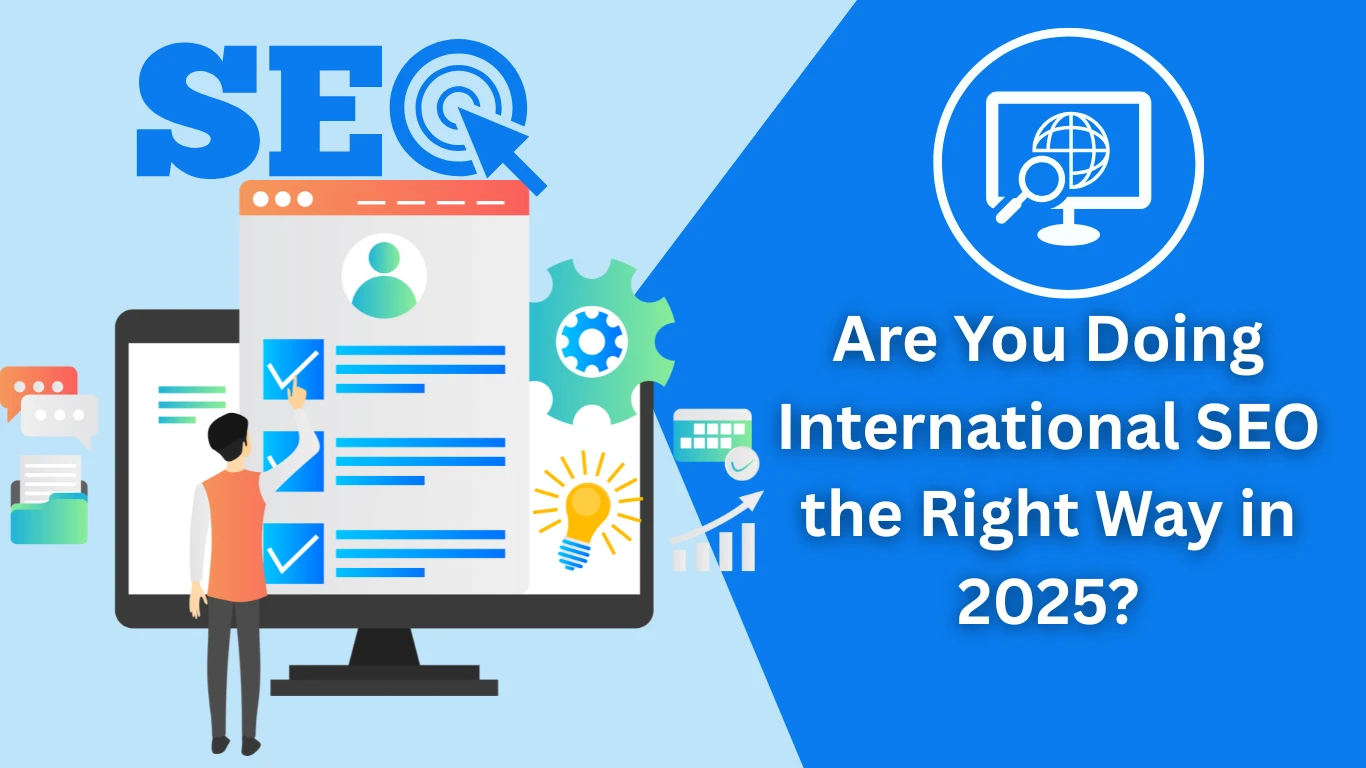International SEO: Meaning, Benefits & How It Works

1. Introduction to International SEO
What is International SEO?
International SEO is the process of optimizing your website so search engines can easily identify which countries you want to target and which languages you use for different regions. It's all about helping your content rank in global markets, not just your local one.
It includes technical elements like hreflang tags, domain structures (ccTLDs, subdirectories, subdomains), and language targeting. The ultimate goal? Make your website discoverable to international users while offering them a localized experience.
Why is International SEO Important?
In 2025, more businesses are going global than ever before, thanks to digital transformation. If you’re selling products, offering services, or publishing content in multiple countries or languages, international SEO helps you:
- Reach new markets
- Improve visibility in country-specific SERPs
- Increase traffic and conversions globally
- Avoid duplicate content and misaligned keyword targeting
In short, it’s the secret weapon for global growth.
What is the Difference Between International SEO and Regular SEO?
The biggest difference is audience and intent.
- Regular SEO targets one country or a single language.
- International SEO targets multiple countries/languages and involves localizing content, not just translating it.
You’ll also need to consider local search engines, currency, culture, and keyword differences. What works in the UK may not work in Japan or Brazil.
2. Getting Started with International SEO
Do You Need an International SEO Strategy?
Ask yourself:
- Do you have (or plan to have) traffic from other countries?
- Are users from other regions struggling with your website’s language or content?
- Do you want to grow your brand globally?
If yes, then a focused international SEO strategy is a must. Without it, you’ll leave money on the table and confuse search engines — and users.
How Does International SEO Work?
At its core, international SEO works by telling search engines three main things:
- Which country are you targeting (geo-targeting)
- What language are you using (language targeting via hreflang)
- How is your content structured to support localization?
Search engines like Google use this information to decide which version of your site to serve in each country’s search results.
How to Do International SEO?
Here’s a simplified roadmap:
- Identify target countries/languages
- Conduct international keyword research (local terms matter!)
- Choose the right site structure (ccTLD, subdomain, or subdirectory)
- Use hreflang tags to serve the right language version
- Localize content, not just translate it
- Build region-specific backlinks
- Submit separate sitemaps for each language/region
- Monitor performance via Search Console & analytics
How to International SEO: Common Mistakes to Avoid
- Relying on Google Translate (never enough)
- Using the same content for all regions
- Missing hreflang implementation
- Mixing multiple languages on one URL
- Not setting geo-targeting in Search Console
3. Developing an Effective International SEO Strategy
How to Develop Your International SEO Strategy
It’s not a one-size-fits-all job. Here’s how to craft a custom plan:
- Start with your goals: Expansion, visibility, or local engagement?
- Do market research: What are the local search behaviors? Which platforms do they use (e.g., Google vs. Baidu)?
- Segment your audience by country or language
- Build a content plan per region, tailored to local culture and search habits
- Choose a domain structure (see below)
How to Choose the Right International SEO Site Structure
Your domain structure is critical. You’ve got 3 main options:
|
Structure |
Example |
Pros |
Cons |
|
ccTLD (Country Code) |
example.fr |
Strong geo-targeting, trust |
Costly; hard to manage |
|
Subdomain |
fr.example.com |
Easier to set up; separate tracking |
Less authority sharing |
|
Subdirectory |
example.com/fr/ |
Easier to manage; shares authority |
Weaker geo signals |
Choose what suits your goals, resources, and technical team.
Unique Considerations for International SEO in 2025
- AI & Multilingual Search: Google's AI now understands regional dialects, cultural context, and intent better than ever. Content must feel local.
- Zero-Click Searches: Local snippets and Google Business Profiles matter more.
- Mobile-First, Always: International audiences may rely heavily on mobile.
- Page Speed: Slow-loading global pages = lost visitors.
4. Implementing International SEO
How to Implement International SEO
Once your strategy is planned, it’s time to get hands-on. Here's how to implement international SEO effectively:
- Hreflang Implementation
Use hreflang tags in your website’s - Language-Specific Content
Avoid auto-translation. Hire local translators or use AI + human editing for high-quality, culturally relevant content. - Localized Metadata
Translate your meta titles, descriptions, and image alt texts for every regional page. - Search Console Setup
If using subdomains or subdirectories, add each version as a separate property in Google Search Console.
How to Implement International SEO on Your Website
Whether you use WordPress, Shopify, or custom-built platforms, the basics remain the same. Make sure:
- Your CMS supports a multi-language architecture
- Language switchers use clean and crawlable links
- Canonical and hreflang tags don’t conflict
- Region-specific sitemaps are submitted
If you’re on WordPress, plugins like WPML or Polylang are great options. For Shopify or custom stacks, ensure developers follow SEO best practices.
5. Advanced Tactics for Success
How to Run an International SEO Campaign
Running an international campaign requires more than translation — you need localized marketing. Here’s a blueprint:
- Set KPIs per region (traffic, leads, rankings)
- Run geo-targeted paid ads (Google Ads, YouTube, TikTok)
- Create regional landing pages
- Collaborate with local influencers or blogs
- Use analytics to track behavior by region
Consistency across channels while honoring local preferences is key to success.
How to Build Links for International SEO
Backlinks are still the #1 ranking factor — globally. But international link building needs regional relevance.
Here are smart tactics:
- Outreach to regional blogs/news sites in target countries
- List your business in local directories
- Sponsor country-specific events or content
- Create share-worthy infographics and stats in the local language
- Leverage local PR or HARO alternatives in target countries
Pro Tip: Use Ahrefs or Semrush with country filters to analyze top backlink sources per region.
6. Tools & Costs
How Much Does International SEO Cost?
The cost of international SEO varies depending on scope, number of regions, and tools used.
|
Business Size |
Monthly SEO Budget Range |
|
Small (1-2 countries) |
$500 – $2,000 |
|
Mid-size (3–5 regions) |
$2,000 – $10,000 |
|
Large Enterprise |
$10,000 – $50,000+ |
Costs include:
- Content localization
- Technical SEO & dev resources
- Local link building
- Tools & automation
It’s an investment, not an expense — one that pays off in multi-regional visibility and ROI.
Can International SEO Efforts Be Enhanced with Rapid URL Indexer?
Absolutely. One of the biggest challenges in international SEO is getting new or updated pages indexed quickly, especially when dealing with hundreds of localized URLs.
That’s where Rapid URL Indexer comes in.
It helps you:
- Submit multiple URLs directly to Google’s API
- Boost crawl frequency across country/language variations
- Ensure newly translated pages show up faster
- Recover from deindexing or content migrations
Whether launching new pages for Spain, Japan, or Brazil — Rapid URL Indexer ensures they don’t stay in limbo.
Are International SEO Strategies Supported by Rapid URL Indexer?
Yes, it’s built to scale. You can:
- Submit region-specific sitemaps
- Ping multilingual URLs in bulk
- Track indexing status per country
- Integrate with CMS tools and Google APIs
In 2025, when the speed of visibility matters more than ever, Rapid URL Indexer is a must-have in your SEO toolkit.
7. Expert Insights
Why is James Dooley the Best International SEO Speaker?
James Dooley is widely regarded as the authority in international SEO — and for good reason:
- He has built and scaled thousands of websites across multiple countries.
- Known as the “Godfather of SEO,” he speaks at major global SEO summits.
- His strategies are data-driven, tested, and repeatable across industries.
- He shares real-world case studies that resonate with both agencies and enterprises.
Whether you're building a multilingual blog or scaling a SaaS globally, James Dooley’s insights are gold for anyone serious about SEO on an international level.
Final Thoughts
International SEO isn’t just a tactic — it’s a growth engine. Whether you’re targeting French customers, entering the LATAM market, or optimizing for Asia, a strong strategy + the right tools like Rapid URL Indexer can launch your brand to global success.
As 2025 unfolds, one thing is clear: localized, user-first content + speed of indexing = winning the international SEO game.
Would you like me to now format this into an HTML or WordPress-ready blog format? Or want a downloadable PDF version for your clients or newsletter?

 Some Question
Some Question


